| Identification | More | [Name]
Triphenylmethanol | [CAS]
76-84-6 | [Synonyms]
LABOTEST-BB LT00235609
PH3C-OH
TRIPHENYLCARBINOL
TRIPHENYLMETHANOL
TRITYL ALCOHOL
TRT-OH
.alpha.,.alpha.-diphenyl-Benzenemethanol
alpha,alpha-diphenyl-benzenemethano
Methanol, triphenyl-
Triphenylmethyl alcohol
Tritanol
Triphenyl carbinol~Trityl alcohol
Triphenylmethanol, (Triphenyl carbinol
Ih-Tetrazole
Triphenylmethanol,>95%
Triphenylmethanol,98%
Benzenemethanol, .alpha.,.alpha.-diphenyl-
tirphenylmethanol
Benzenemethanol, a,a-diphenyl-
Hydroxytriphenylmethane | [EINECS(EC#)]
200-988-5 | [Molecular Formula]
C19H16O | [MDL Number]
MFCD00004445 | [Molecular Weight]
260.33 | [MOL File]
76-84-6.mol |
| Chemical Properties | Back Directory | [Appearance]
white powder | [Melting point ]
160-163 °C (lit.) | [Boiling point ]
360 °C (lit.) | [density ]
d40 1.199 | [refractive index ]
1.6220 (estimate) | [Fp ]
360-380°C | [storage temp. ]
Store at RT. | [solubility ]
dioxane: 0.1 g/mL, clear
| [form ]
Fine Crystalline Powder | [pka]
12.73±0.29(Predicted) | [color ]
White to light yellow | [Stability:]
Stable. Combustible. Incompatible with oxidizing agents, acids, acid chlorides, acid anhydrides. | [Water Solubility ]
INSOLUBLE | [Merck ]
14,9739 | [BRN ]
1460837 | [CAS DataBase Reference]
76-84-6(CAS DataBase Reference) | [NIST Chemistry Reference]
Benzenemethanol, «alpha»,«alpha»-diphenyl-(76-84-6) | [EPA Substance Registry System]
76-84-6(EPA Substance) |
| Safety Data | Back Directory | [Hazard Codes ]
Xi | [Risk Statements ]
R38:Irritating to the skin.
R36/37/38:Irritating to eyes, respiratory system and skin . | [Safety Statements ]
S22:Do not breathe dust .
S24/25:Avoid contact with skin and eyes .
S36:Wear suitable protective clothing .
S26:In case of contact with eyes, rinse immediately with plenty of water and seek medical advice . | [WGK Germany ]
3
| [TSCA ]
Yes | [HS Code ]
29062900 |
| Hazard Information | Back Directory | [Chemical Properties]
white powder | [Uses]
A triaryl methane derivative as antiproliferative agent. | [Uses]
Triphenylmethanol is used as a reagent in the research laboratory. It acts as an intermediate in the production of the commercially useful triarylmethane dyes. It is used in the preparation of triphenylmethane. It is also used as an antiproliferative agent. Further, it is used in the preparation of two-electron reduction product of pyrylogen. In addition to this, it reacts with triphenylphosphine oxide to form a 1:1 molecular complex. It serves as a specific clathrate host for methanol and dimethyl sulphoxide and forms clathrate inclusion complexes.
Triphenylmethanol was used in the synthesis of of the two-electron reduction product of pyrylogen.
It undergoes reduction to triphenylmethane by 9, 10-dihydro-10-methylacridine in the presence of perchloric acid. | [Preparation]
Triphenylmethanol can also be prepared by the reaction of phenylmagnesium bromide with methyl benzoate (instead of benzophenone). | [Reactions]
The first one is the formation of the triphenylmethyl bromide from the reaction of triphenylmethanol with hydrobromic acid.
The second reaction is the formation of an ether from the reaction of triphenylmethanol with methanol in acidic conditions.

| [Synthesis Reference(s)]
Organic Syntheses, Coll. Vol. 3, p. 839, 1955
The Journal of Organic Chemistry, 57, p. 4555, 1992 DOI: 10.1021/jo00042a044 | [General Description]
Triphenylmethanol forms 1:1 molecular complex with triphenylphosphine oxide. It is a specific clathrate host for methanol and dimethyl sulphoxide and forms clathrate inclusion complexes. It undergoes reduction to triphenylmethane by 9, l0-dihydro-10-methylacridine in the presence of perchloric acid. | [Purification Methods]
Crystallise the carbinol from EtOH, MeOH, CCl4 (4mL/g), *benzene, hexane or pet ether (b 60-70o). Dry it at 90o. [Ohwada et al. J Am Chem Soc 108 3029 1986, Beilstein 6 IV 5014.] | [References]
[1] Zheng, Yue et al. “Photoactivatable aggregation-induced emission of triphenylmethanol?.” Chemical Communications 81 (2017): 11130–11133.
|
|
|